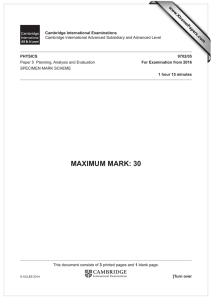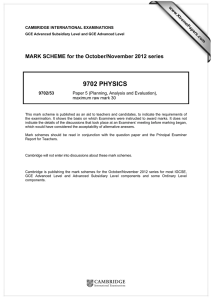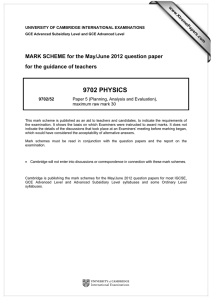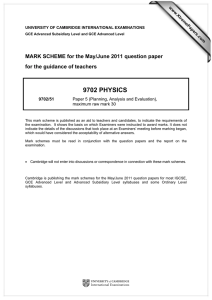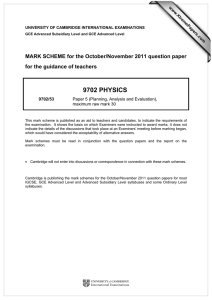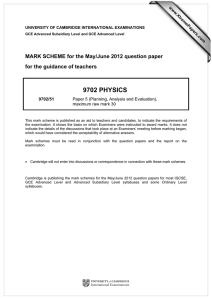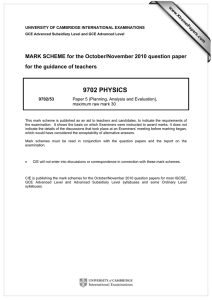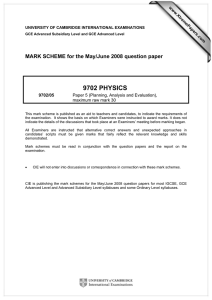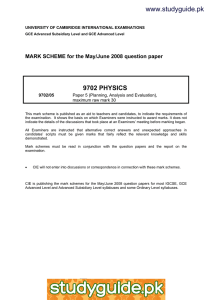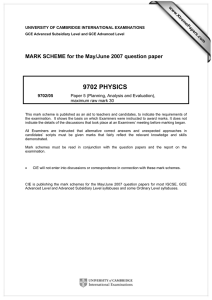9702 PHYSICS MARK SCHEME for the May/June 2013 series
advertisement
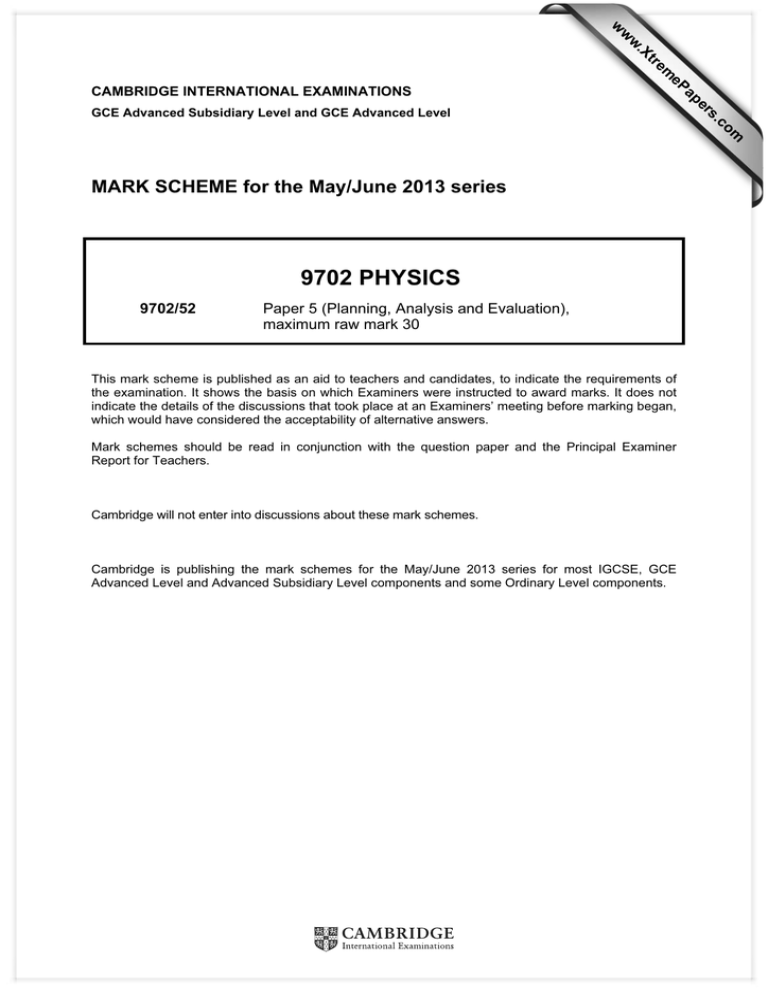
w w ap eP m e tr .X w CAMBRIDGE INTERNATIONAL EXAMINATIONS 9702 PHYSICS 9702/52 Paper 5 (Planning, Analysis and Evaluation), maximum raw mark 30 This mark scheme is published as an aid to teachers and candidates, to indicate the requirements of the examination. It shows the basis on which Examiners were instructed to award marks. It does not indicate the details of the discussions that took place at an Examiners’ meeting before marking began, which would have considered the acceptability of alternative answers. Mark schemes should be read in conjunction with the question paper and the Principal Examiner Report for Teachers. Cambridge will not enter into discussions about these mark schemes. Cambridge is publishing the mark schemes for the May/June 2013 series for most IGCSE, GCE Advanced Level and Advanced Subsidiary Level components and some Ordinary Level components. om .c MARK SCHEME for the May/June 2013 series s er GCE Advanced Subsidiary Level and GCE Advanced Level Page 2 1 Mark Scheme GCE AS/A LEVEL – May/June 2013 Syllabus 9702 Paper 52 Planning (15 marks) Defining the problem (3 marks) P f is the independent variable or vary f. [1] P I0 is the dependent variable or measure I0. [1] P Keep V0 constant. [1] Methods of data collection (5 marks) M Labelled/ workable circuit diagram of apparatus: including coil connected to power supply/signal generator. [1] M Variable frequency ac power supply or signal generator (method of varying frequency). [1] M Measure current using ammeter or p.d. across resistor. [1] M Measure V across power supply or across coil e.g. voltmeter or c.r.o. explained. [1] M Measure f using oscilloscope/read off signal generator. [1] Method of analysis (2 marks) A Plot a graph of 1/I02 against f 2 or V02/I02 against f 2 or equivalent. Do not allow log-log graph. A L= V02 gradient V0 = gradient or L = 2π 4π 2 [1] gradient 4π 2 [1] Safety considerations (1 mark) S Reasoned method to prevent overheating of coil or burns from coil. [1] Additional detail (4 marks) D 1 2 3 4 5 6 7 8 Relevant points might include Use lower frequencies to produce larger currents Keep resistance of circuit/coil constant Additional detail on measuring T using timebase f = 1 / period Additional detail on measuring V0 using y-gain Relationship is valid if straight line, provided plotted graph is correct Relationship is valid if straight line not passing through origin, provided plotted graph is correct (any quoted expression must be correct) Detail on changing r.m.s. to peak [4] Do not allow vague computer methods. Ignore reference to iron core / other magnetic fields. [Total: 15] © Cambridge International Examinations 2013 Page 3 2 Mark Scheme GCE AS/A LEVEL – May/June 2013 Syllabus 9702 Paper 52 Analysis, conclusions and evaluation (15 marks) Mark Expected Answer (a) A1 (b) T1 a2 / 10–4 m2 T2 44 or 43.6 Gradient = Additional Guidance 4b E Column heading. Allow equivalent unit. Do not award if 10–4 omitted. A mixture of 2 s.f. and 3 s.f. is allowed. 52 or 51.8 61 or 60.8 71 or 70.6 79 or 79.2 88 or 88.4 (c) (i) (c) (ii) (c) (iii) U1 1.3 increasing to 1.9 Allow 1 increasing to 2. G1 Six points plotted correctly Must be within half a small square. Ecf allowed from table. Penalise ‘blobs’. U2 All error bars in a2 plotted correctly Must be within half a small square. Ecf allowed from table. G2 Line of best fit If points are plotted correctly then lower end of line should pass between (1000, 43) and (1000,44.5) and upper end of line should pass between (2000, 87) and (2000, 89). Allow ecf from points plotted incorrectly – examiner judgement. G3 Worst acceptable straight line. Steepest or shallowest possible line that passes through all the error bars. Line should be clearly labelled or dashed. Should pass from top of top error bar to bottom of bottom error bar or bottom of top error bar to top of bottom error bar. Mark scored only if error bars are plotted. C1 Gradient of best fit line The triangle used should be at least half the length of the drawn line. Check the read offs. Work to half a small square. Do not penalise POT. U3 Uncertainty in gradient Method of determining absolute uncertainty Difference in worst gradient and gradient. © Cambridge International Examinations 2013 Page 4 Mark Scheme GCE AS/A LEVEL – May/June 2013 Syllabus 9702 Paper 52 C2 E = 4b/gradient Method required. Do not check calculation. Should be about 36 000. Do not penalise POT error. C3 V m–1 or N C–1 Penalise POT error. (d) (ii) U4 Percentage uncertainty in E Must be greater than 2.5%. (e) C4 V = 540 to 580 V and given to 2 or 3 s.f. Working must be correct; check for inconsistent units. Must be in stated range. U5 Absolute uncertainty in V (d) (i) [Total: 15] Uncertainties in Question 2 (c) (iii) Gradient [U3] Uncertainty = gradient of line of best fit – gradient of worst acceptable line Uncertainty = ½ (steepest worst line gradient – shallowest worst line gradient) (d) [U4] Percentage uncertainty = max b min m min b min E = max m ∆E × 100 E max E = ∆m ∆b ∆m + Percentage uncertainty = × 100 = × 100 + 2.5 b m m (e) [U5] Absolute uncertainty = max V – V = V – min V = max V = max E × max a 2 max a 2 = 4 min b min m min V = min E × min a 2 min a 2 = 4 max b max m max V − minV 2 2∆a ∆m 2∆a ∆E ∆b + + + Absolute uncertainty = V = V m E b a a © Cambridge International Examinations 2013
